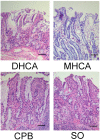Moderate Hypothermia Provides Better Protection of the Intestinal Barrier than Deep Hypothermia during Circulatory Arrest in a Piglet Model: A Microdialysis Study
- PMID: 27685257
- PMCID: PMC5042434
- DOI: 10.1371/journal.pone.0163684
Moderate Hypothermia Provides Better Protection of the Intestinal Barrier than Deep Hypothermia during Circulatory Arrest in a Piglet Model: A Microdialysis Study
Abstract
Introduction: This study aimed to assess the effects of different temperature settings of hypothermic circulatory arrest (HCA) on intestinal barrier function in a piglet model.
Methods: Twenty Wuzhishan piglets were randomly assigned to 40 min of HCA at 18°C (DHCA group, n = 5), 40 min of HCA at 24°C (MHCA group, n = 5), normothermic cardiopulmonary bypass (CPB group, n = 5) or sham operation (SO group, n = 5). Serum D-lactate (SDL) and lipopolysaccharide (LPS) levels were determined. Microdialysis parameters (glucose, lactate, pyruvate and glycerol) in the intestinal dialysate were measured. After 180 min of reperfusion, intestinal samples were harvested for real-time polymerase chain reaction and western blotting measurements for E-cadherin and Claudin-1.
Results: Higher levels of SDL and LPS were detected in the DHCA group than in the MHCA group (P < 0.001). Both MHCA and DHCA groups exhibited lower glucose levels, higher lactate and glycerol levels and a higher lactate to pyruvate (L/P) ratio compared with the CPB group (p<0.05); the DHCA group had higher lactate and glycerol levels and a higher L/P ratio (p<0.05) but similar glucose levels compared to the MHCA group. No significant differences in E-cadherin mRNA or protein levels were noted. Upregulation of claudin-1 mRNA levels was detected in both the DHCA and MHCA animals' intestines (P < 0.01), but only the DHCA group exhibited a decrease in claudin-1 protein expression (P < 0.01).
Conclusion: HCA altered the energy metabolism and expression of epithelial junctions in the intestine. Moderate hypothermia (24°C) was less detrimental to the markers of normal functioning of the intestinal barrier than deep hypothermia (18°C).
Conflict of interest statement
The authors have declared that no competing interests exist.
Figures








Similar articles
-
Is selective antegrade cerebral perfusion superior to retrograde cerebral perfusion for brain protection during deep hypothermic circulatory arrest? Metabolic evidence from microdialysis.Crit Care Med. 2014 May;42(5):e319-28. doi: 10.1097/CCM.0000000000000220. Crit Care Med. 2014. PMID: 24561569
-
Cerebral metabolism during deep hypothermic circulatory arrest vs moderate hypothermic selective cerebral perfusion in a piglet model: a microdialysis study.Paediatr Anaesth. 2009 Aug;19(8):770-8. doi: 10.1111/j.1460-9592.2009.03074.x. Paediatr Anaesth. 2009. PMID: 19624364
-
Retrograde Cerebral Perfusion Results in Better Perfusion to the Striatum Than the Cerebral Cortex During Deep Hypothermic Circulatory Arrest: A Microdialysis Study.Artif Organs. 2016 Mar;40(3):270-7. doi: 10.1111/aor.12551. Epub 2015 Sep 2. Artif Organs. 2016. PMID: 26333187
-
Moderate hypothermia during aortic arch surgery is associated with reduced risk of early mortality.J Thorac Cardiovasc Surg. 2013 Sep;146(3):662-7. doi: 10.1016/j.jtcvs.2013.03.004. Epub 2013 Apr 1. J Thorac Cardiovasc Surg. 2013. PMID: 23558304
-
Global and regional cerebral blood flow in neonatal piglets undergoing pulsatile cardiopulmonary bypass with continuous perfusion at 25 degrees C and circulatory arrest at 18 degrees C.Perfusion. 2001 Nov;16(6):503-10. doi: 10.1177/026765910101600610. Perfusion. 2001. PMID: 11761090
Cited by
-
Deep Hypothermic Circulatory Arrest Does Not Show Better Protection for Vital Organs Compared with Moderate Hypothermic Circulatory Arrest in Pig Model.Biomed Res Int. 2019 Apr 17;2019:1420216. doi: 10.1155/2019/1420216. eCollection 2019. Biomed Res Int. 2019. PMID: 31119151 Free PMC article.
-
Cardiopulmonary bypass with deep hypothermic circulatory arrest results in organ-specific transcriptomic responses in pediatric swine.Transl Res. 2025 Mar;277:64-74. doi: 10.1016/j.trsl.2025.01.002. Epub 2025 Jan 17. Transl Res. 2025. PMID: 39827912
-
MicroRNA expression in the hippocampal CA1 region under deep hypothermic circulatory arrest.Neural Regen Res. 2019 Nov;14(11):2003-2010. doi: 10.4103/1673-5374.253174. Neural Regen Res. 2019. PMID: 31290459 Free PMC article.
-
Critical evaluation of colon submucosal microdialysis in awake, mobile rats.PLoS One. 2018 Jan 11;13(1):e0191041. doi: 10.1371/journal.pone.0191041. eCollection 2018. PLoS One. 2018. PMID: 29324792 Free PMC article.
References
-
- Riddington DW, Venkatesh B, Boivin CM, Bonser RS, Elliott TS, Marshall T, et al. Intestinal permeability, gastric intramucosal pH, and systemic endotoxemia in patients undergoing cardiopulmonary bypass. Jama. 1996;275(13):1007–12. Epub 1996/04/03. . - PubMed
-
- Khaladj N, Peterss S, Pichlmaier M, Shrestha M, von Wasielewski R, Hoy L, et al. The impact of deep and moderate body temperatures on end-organ function during hypothermic circulatory arrest. Eur J Cardiothorac Surg. 2011;40(6):1492–9; discussion 9. Epub 2011/05/03. 10.1016/j.ejcts.2011.03.031 . - DOI - PubMed
LinkOut - more resources
Full Text Sources
Other Literature Sources

